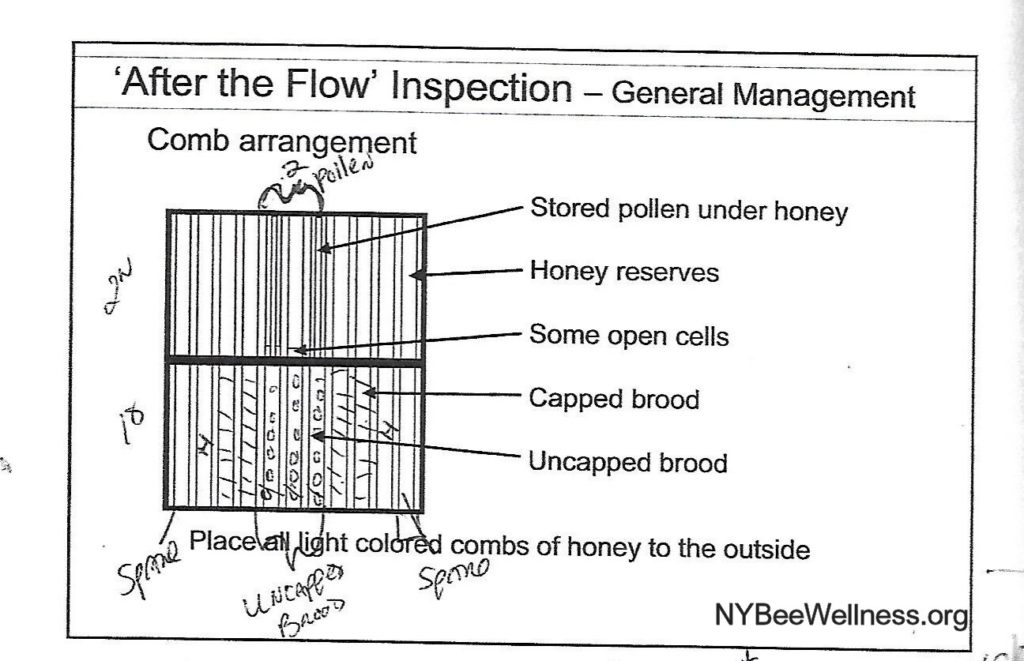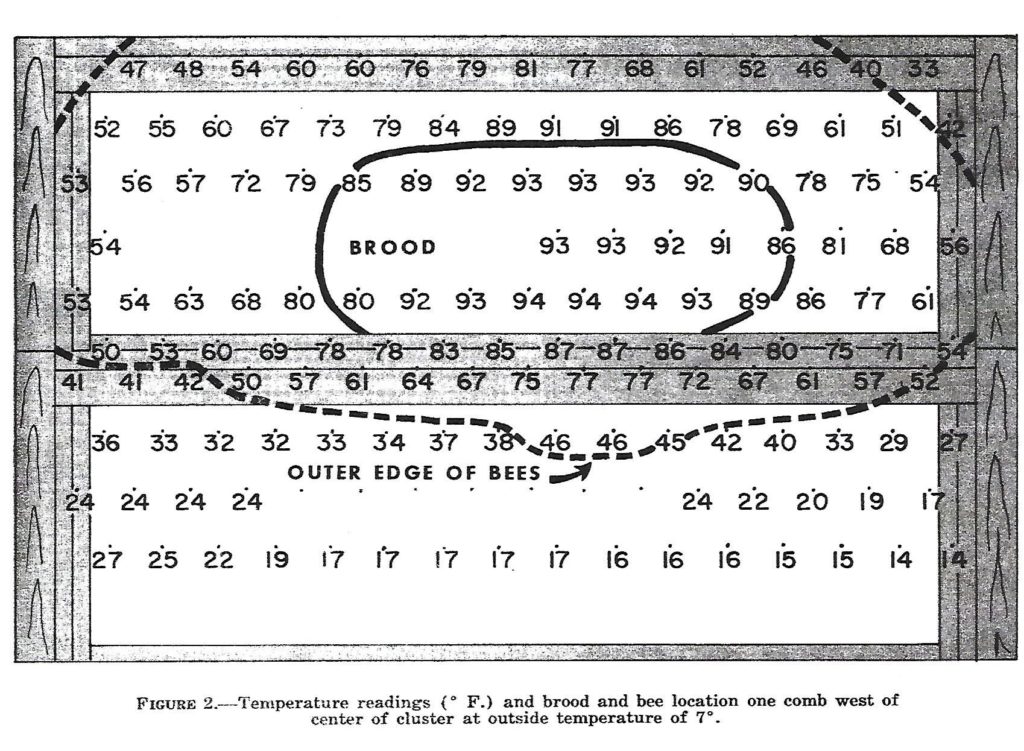Wintering
ARE YOUR HIVES READY FOR WINTER?
A synopsis of Best Management Practices
(BMPs), from the Ontario Bee Journal
1. HAVE THEY GOT ENOUGH TO EAT?
Providing sufficient food stores will minimize the chances of starvation
for a healthy populous colony. If they are short on stores, you may
need to feed fondant or pollen supplement in late winter/early spring.
• Going into winter, single brood colonies should weigh at least 31.9
km/70 lb, doubles 45.5 kg/100 lb.
• A full size colony with a fall honey crop typically requires 15L
(4 gal) of supplement feed. Bees need to be fed before it gets too
cold for them to access (about 13°C/55F). Colonies should be
fed thick syrup (2:1 sugar/water).
2. HAVE THEY GOT A GOOD SIZE POPULATION GOING INTO WINTER?
A large cluster of bees will be able to keep warm without using as much
energy and feed. The larger the colony, the more likely it is to make it
to spring. Seven to eight frames of bees in a full-sized colony are ideal in
most of Ontario. Milder climates can get away with less.
3. IS THE COLONY HEALTHY AND RELATIVELY PEST FREE
(PARTICULARLY VARROA)?
• Did you inspect your brood chambers and monitor throughout
the summer and into the fall?
• If your varroa mite levels required treatment, did you treat early?
If higher varroa levels persist into fall, the bees that are raised for
winter will be weakened and the colony will go into the winter in
poor health.
• Did you monitor before and after treatment?
4. DID YOU WRAP YOUR COLONIES FOR WINTER?
• Place material (paper, cardboard, insulated plastic, Styrofoam,
wooden boxes with wood shavings, etc) on or around the exterior
of the hive for insulation/windbreak.
• Reduce the entrance of the colony.
• Provide upper ventilation with the insulation for excess moisture
and CO2 release.
Excerpt from The Northeast Beekeeper Apprentice Level Fall Course 2008
7 page excerpt; N. W. Calderone, Cornell University
The Biology and Management of Colonies in Winter
Adony Melathopoulos
Beaverlodge Research Farm, Box 29, Beaverlodge, AB T0H 0C0 melathopoulosa@agr.gc.ca
The Biology of Wintering
In nature bees have two general methods for maintaining colony temperatures in winter: 1) selecting a protected and well-suited cavity (Tab. 1) and 2) clustering.
Clusters have a two-part structure (Fig. 1): 1) a dense outer mantle in which bees jam together, orienting their heads towards the center of the cluster and 2) a loose inner core where bees are free to move. The mantle insulates and, at its tightest, approaches the insulation of bird feathers or mammal fur (0.1 W/kg/ºC). Clusters move slowly from empty combs to ones full of honey. This movement is typically upwards and sideways, never downwards.
Before we go on, here are four critical temperatures you should know: 1) brood nest = 32-36ºC, 2) minimum thorax temperature needed for flight = 27ºC, 3) minimum temperature needed to pump flight muscles and warm up (analogous to mammal “shivering”) = 18ºC and 4) below which bees go into a “chill coma” = 6ºC.
broodnest area
Bees begin clustering when temperatures fall below 18ºC. Cluster size shrinks until -10ºC at which the cluster is tightest. The cluster shrinks 5-fold between 18ºC and -10ºC. Below -10ºC hive temperatures can only be maintained by increasing core heat production (Fig. 2). The core bees create this heat by “pumping” their flight muscles. This process is ultimately fueled by honey which prompted WF Cheshire to write in 1888: “Each bee… is a tiny furnace carrying on a process in its tissues and fluids which is the exact chemical equivalent of oxidizing honey…”.
WORDS OF WISDOM – A hive’s metabolic rate is lowest when temperatures are 5-10ºC. This is why beekeepers who winter bees indoors maintain their buildings at 5ºC: the bees use the least amount of honey at this temperature.
It is estimated that bees produce 0.68 kg of water per kg of honey…
THE THERMOLOGY OF WINTERING HONEY BEE COLONIES Technical Bulletin No. 1429
By CHARLES D. OWENS, Agricultural Engineering Research Division, Agricultural Research Service, 1971
38 page document with many graph and diagrams of winter honey bee clusters and temperatures
Resources
-

ARE YOUR HIVES READY FOR WINTER?
A synopsis of Best Management Practices
(BMPs), from the Ontario Bee Journal 2014 -

Excerpt from The Northeast Beekeeper Apprentice Level Fall Course 2008
featuring winter frame arrangement diagram, above
-

The Biology and Management of Colonies in Winter
Adony Melathopoulos; wintering in Alberta
-

THE THERMOLOGY OF WINTERING HONEY BEE COLONIES Technical Bulletin No. 1429
38 page document with many graphs and diagrams of winter honey bee clusters and temperatures
-

Over Wintering of Russian Honey Bees in north eastern Iowa
Villa, Rinderer, Bigalk; 2009, Science of Bee Culture


